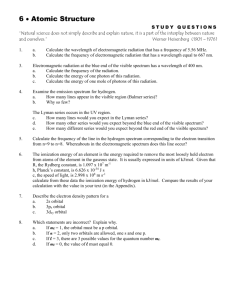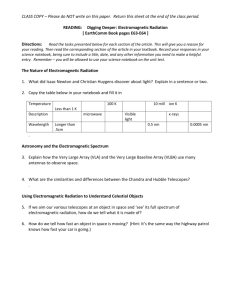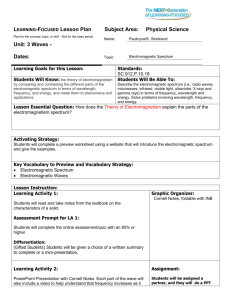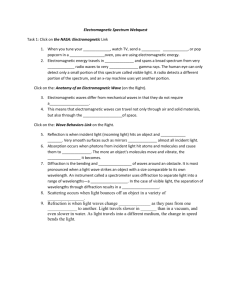Physics P1 Topic 2 - Downham Market Academy
advertisement
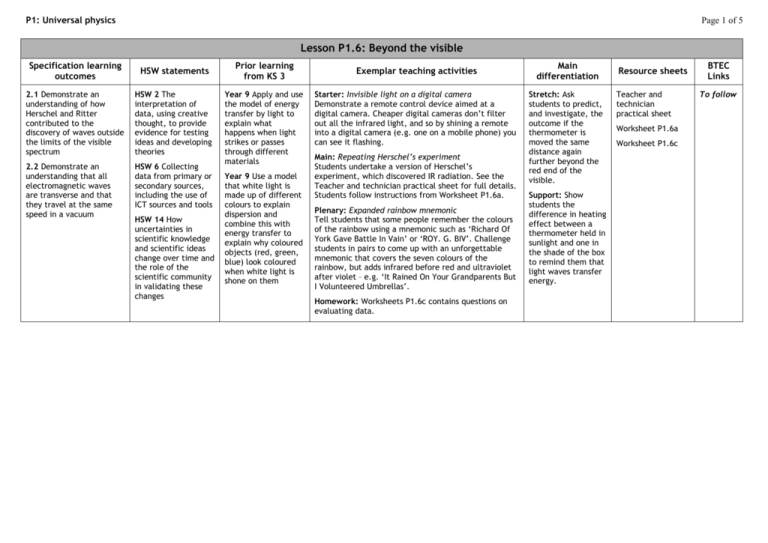
P1: Universal physics Page 1 of 5 Lesson P1.6: Beyond the visible Specification learning outcomes HSW statements 2.1 Demonstrate an understanding of how Herschel and Ritter contributed to the discovery of waves outside the limits of the visible spectrum HSW 2 The interpretation of data, using creative thought, to provide evidence for testing ideas and developing theories 2.2 Demonstrate an understanding that all electromagnetic waves are transverse and that they travel at the same speed in a vacuum HSW 6 Collecting data from primary or secondary sources, including the use of ICT sources and tools HSW 14 How uncertainties in scientific knowledge and scientific ideas change over time and the role of the scientific community in validating these changes Prior learning from KS 3 Year 9 Apply and use the model of energy transfer by light to explain what happens when light strikes or passes through different materials Year 9 Use a model that white light is made up of different colours to explain dispersion and combine this with energy transfer to explain why coloured objects (red, green, blue) look coloured when white light is shone on them Exemplar teaching activities Starter: Invisible light on a digital camera Demonstrate a remote control device aimed at a digital camera. Cheaper digital cameras don’t filter out all the infrared light, and so by shining a remote into a digital camera (e.g. one on a mobile phone) you can see it flashing. Main: Repeating Herschel’s experiment Students undertake a version of Herschel’s experiment, which discovered IR radiation. See the Teacher and technician practical sheet for full details. Students follow instructions from Worksheet P1.6a. Plenary: Expanded rainbow mnemonic Tell students that some people remember the colours of the rainbow using a mnemonic such as ‘Richard Of York Gave Battle In Vain’ or ‘ROY. G. BIV’. Challenge students in pairs to come up with an unforgettable mnemonic that covers the seven colours of the rainbow, but adds infrared before red and ultraviolet after violet – e.g. ‘It Rained On Your Grandparents But I Volunteered Umbrellas’. Homework: Worksheets P1.6c contains questions on evaluating data. Main differentiation Stretch: Ask students to predict, and investigate, the outcome if the thermometer is moved the same distance again further beyond the red end of the visible. Support: Show students the difference in heating effect between a thermometer held in sunlight and one in the shade of the box to remind them that light waves transfer energy. Resource sheets Teacher and technician practical sheet Worksheet P1.6a Worksheet P1.6c BTEC Links To follow P1: Universal physics Page 2 of 5 Lesson P1.7: The electromagnetic spectrum Specification learning outcomes 2.2 Demonstrate an understanding that all electromagnetic waves are transverse and that they travel at the same speed in a vacuum 2.3 Describe the continuous electromagnetic spectrum including (in order) radio waves, microwaves, infrared, visible (including the colours of the visible spectrum), ultraviolet, Xrays and gamma rays 2.4 Demonstrate an understanding that the electromagnetic spectrum is continuous from radio waves to gamma rays, but the radiations within it can be grouped in order of decreasing wavelength and increasing frequency HSW statements HSW 10 Using both qualitative and quantitative approaches Prior learning from KS 3 N/A Exemplar teaching activities Starter: Herschel and Ritter go further Recap how it was that Herschel came upon his discovery of IR somewhat accidentally, and then Johann Ritter tested a consequent hypothesis rigorously in order to discover UV. Ask the students to write out the colours of the visible spectrum with IR and UV added on the ends. Looking at the list, ask the question ‘What should Ritter try next?’ Explain that there are more waves further out, and that different detectors are needed for the various types. This can be exemplified by the fact that Herschel used thermometers but Ritter used the reaction of silver chloride to detect UV. Main: EM spectrum practical circus In pairs or small groups, depending on the availability of equipment, students undertake a series of brief practical investigations to familiarise themselves with the various parts of the electromagnetic spectrum not visible to the eye, and to show that there are ways of detecting each type of wave and that each can transfer energy. Students will need Worksheet P1.7a. See the Teacher and technician practical sheet for full details. Plenary: Start my sentence In pairs, the students write the ends of three sentences each. These are swapped and their partner must write the first part of the sentence, so that it makes sense and is correct physics. Each sentence ending must use a word from a list on the board, such as ‘vacuum’, ‘transverse’, ‘spectrum’, ‘wavelength’ or ‘frequency’. Homework: Students record one instance for each part of the EM spectrum of where they have seen or heard about it. They should write a few sentences for each explaining where they came across it and what they learnt. Main differentiation Resource sheets Stretch: Ask students additional questions to elicit the idea that, although we divide the spectrum into different types of radiation that may overlap in wavelength, the spectrum is continuous. Teacher and technician practical sheet Support: Students could be paired with more able students. Worksheet P1.7a BTEC Links To follow P1: Universal physics Page 3 of 5 Lesson P1.8: Electromagnetic dangers Specification learning outcomes 2.5 Demonstrate an understanding that the potential danger associated with an electromagnetic wave increases with increasing frequency 2.6 Relate the harmful effects, to life, of excessive exposure to the frequency of the electromagnetic radiation, including: a) microwaves: internal heating of body cells b) infrared: skin burns c) ultraviolet: damage to surface cells and eyes, leading to skin cancer and eye conditions d) X-rays and gamma rays: mutation or damage to cells in the body HSW statements N/A Prior learning from KS 3 N/A Exemplar teaching activities Main differentiation Starter: Danger lists Ask students to make a list of any dangers that they already know of for different parts of the electromagnetic spectrum. A useful prompt might be to start with listing the seven parts of the EM spectrum, either individually atop their lists, or on the board for reference. These lists should be the starting point for a class discussion of the dangers. Stretch: Ask students to research sources to support their evidence, and assess the quality of those sources. Main: Mobile phone debate Introduce this exercise by showing a video (see below) of mobile phones being used to pop popcorn. Then chair a debate as to whether or not there are health hazards associated with using mobile telephones, taking into account calls against texts or Internet use, and quantity of use. Students write out some bullet points to support an argument for or against. Hazards can include consequential problems like driver distraction. Each group should then present their ideas listed on a big sheet of flipchart or poster paper. Website ‘HPA mobile phone dangers’ will give the current scientific evidence for health hazards from mobile phones and masts. The exercise can be closed by showing the YouTube video of the viral marketer who faked the phone-popcorn videos explaining on CNN how it was done. Support: Students could be grouped with more able students and use the introduction on Student Book spread P1.8 to cite the dangers. Plenary: Electromagnetic waves dangers Use the cards in Worksheet P1.8a. Deal four cards to each student. Draw and read out a random card yourself. Students raise their hand if they think they have a matching card. A student who correctly says they have a matching card can give that card to the teacher. If the card is wrong, they must take an additional card from the teacher, and play starts again. The winner is the first student to get rid of all their cards. Homework: Ask students to invent and draw a hazard symbol for each danger from the electromagnetic spectrum. The target should be to consider each type of electromagnetic wave and either produce a sign or justify that there is no need. They should suggest where each sign might be used. Resource sheets Worksheet P1.8a BTEC Links To follow P1: Universal physics Page 4 of 5 Lesson P1.9: Using electromagnetic radiation Specification learning outcomes 2.7 Describe some uses of electromagnetic radiation: a) radio waves: including broadcasting, communications and satellite transmissions b) microwaves: including cooking, communications and satellite transmissions c) infrared: including cooking, thermal imaging, short range communications, optical fibres, television remote controls and security systems d) visible light: including vision, photography and illumination e) ultraviolet: including security marking, fluorescent lamps, detecting forged bank notes and disinfecting water f) X-rays: including observing the internal structure of objects, airport security scanners and medical X-rays g) gamma rays: including sterilising food and medical equipment, and the detection of cancer and its treatment HSW statements HSW 12 The use of contemporary science and technological developments and their benefits, drawbacks and risks Prior learning from KS 3 N/A Exemplar teaching activities Main differentiation Starter: Detecting counterfeits Hold up a £20 note and ask what is special about the note that makes it hard to copy, and how you can check that it is genuine. Write students’ ideas on the board. Demonstrate with a UV lamp how to check for forgeries. Stretch: Students find out about more than one use per part of the electromagnetic spectrum. Main: EM uses research Students undertake research in order to produce and complete a table of uses for parts of the electromagnetic spectrum, completing the grid on Worksheet P1.9a. A collection of old textbooks, and possibly some magazines, could be used as prompt/research material, along with the Internet Support: Students could be offered some page references in the books supplied. Plenary: Beg of my neighbour Ask each student to write down three things that they think the person sitting next to them should have learnt and when they would have learnt it. Then tell them to ask each other in pairs whether they agree about the things they should have learnt. Ask them to agree a final list of the points. Homework: Ask students to write a completely open-ended piece of creative writing – a story entirely of their own choosing. However, it must contain at least two examples of uses of each part of the electromagnetic spectrum (i.e. 14 uses in total). The less contrived the better. Resource sheets Worksheet P1.9a BTEC Links To follow P1: Universal physics Page 5 of 5 Lesson P1.10: Ionising radiation Specification learning outcomes 2.8 Recall that ionising radiations are emitted all the time by radioactive sources 2.9 Describe that ionising radiation includes alpha and beta particles and gamma rays and that they transfer energy HSW statements HSW 12 The use of contemporary science and technological developments and their benefits, drawbacks and risks Prior learning from KS 3 N/A Exemplar teaching activities Starter: Mystery containers Take three opaque containers and put some ground coffee in one, soil in another and crumpled paper in another. Test each with a GM tube/counter and ask students what they think is happening and what is in each container. Elicit the idea that each container has something inside that is giving out energy that is being picked up by the GM tube/counter. Main: Radiation demonstration Demonstrate a Geiger-Muller tube, explaining that it can detect charged atoms (ions) and that radiation entering the tube creates ions in the gas inside it. A number of different radioactive sources should be tested to highlight alpha, beta and gamma sources. See the Teacher and technician practical sheet for full details. Plenary: Ionising radiation: the facts Ask each student to write down three facts that he/she has learnt during the topic. Then ask students to share their facts in groups and to compile a master list of facts, including the most common fact learnt and the least common fact. Select a spokesperson for one group at random to share their ideas with the class. Then ask whether other groups had the same ‘most common fact’. Homework: Worksheets P1.10b (for students requiring extra support) and P1.10c (for those working at a higher level) contain questions on ionising radiation. Main differentiation Resource sheets Stretch: Students should be asked to explain why the manufacture of luminous watches and gas mantles with radioactive materials (even if these have not been demonstrated) was revised. Teacher and technician practical sheet Support: Students should be focused to the specification points of continuous radioactive emission, ionisation, and the existence of alpha, beta and gamma as separate types. Worksheet P1.10b Worksheet P1.10c BTEC Links To follow



